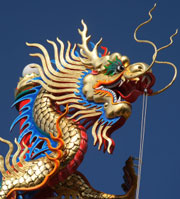Researchers from the Hunan University of TCM (Traditional Chinese Medicine) compared acupuncture techniques for the treatment of lower back pain. The dragon and tiger fighting method was compared with the uniform reinforcing-reducing method and standard physiotherapy. The dragon and tiger fighting method bested the two other treatment modalities for superior relief of lower back pain.
 Chinese DragonEach acupuncture technique was tested using two separate acupuncture point prescriptions. One set of points was UB23 (Shenshu), UB25 (Dachangshu) and UB40 (Weizhong) plus Ahshi points. The other set of acupuncture points was a combination of UB24 (Qihaishu), UB26 (Guanyuanshu), UB60 (Kunlun) and GV3 (Yaoyangguan). In both cases, the dragon and tiger fighting technique beat out the uniform reinforcing-reduction method.
Chinese DragonEach acupuncture technique was tested using two separate acupuncture point prescriptions. One set of points was UB23 (Shenshu), UB25 (Dachangshu) and UB40 (Weizhong) plus Ahshi points. The other set of acupuncture points was a combination of UB24 (Qihaishu), UB26 (Guanyuanshu), UB60 (Kunlun) and GV3 (Yaoyangguan). In both cases, the dragon and tiger fighting technique beat out the uniform reinforcing-reduction method.
The Dragon and Tiger Method
The dragon and tiger fighting method involves alternately rotating the needle to the left nine times and rotating the acupuncture needle to the right six times. The dragon, Zi, is Yang and the tiger, Wu, is Yin. The dragon stands for the strengthening techniques of rotating to the left and the number 9, a Yang number. The tiger stands for the reducing method of rotating the needle to the right and the number 6, a Yin number. The motion of rotation is generated by rotating the needle by moving the thumb forward for the dragon technique and moving the thumb backwards for the tiger technique. Fighting stands for the alternation of rotating from one direction to the other.
There have been many studies in recent history demonstrating the efficacy of acupuncture for the reduction of bodily pain including that of lower back pain. There is a distinct contrast between studies incorporating acupuncture needling techniques and those that involve merely inserting the acupuncture needle without any needle manipulation or the arrival of the de qi sensation. An interesting investigation would be a meta-analysis of the clinical efficacy rate found in studies using advanced manual acupuncture needling techniques versus studies using only simple acupuncture needle insertion.
In general, researchers face obvious limitations. In an effort to standardize investigations, researchers often choose a set acupuncture point prescription. However, acupuncturists often customize the acupuncture point prescription, needling techniques, choice of needle types and duration of needle retention based on the patient’s differential diagnosis. Electroacupuncture, moxibustion, far infrared heat, cupping and other modalities may be combined during the acupuncture treatment to assist in eliciting a superior clinical outcome.
Perhaps the most unusual recent study compared two acupuncture points, SP6 (Sanyinjiao) and GB39 (Xuanzhong), for the treatment of dysmenorrhea. The researchers assumed that SP6 was relevant to the treatment of dysmenorrhea and they used GB39 as a control measure under the assumption that it is unrelated to the treatment of dysmenorrhea. The researchers concluded that “SP6 is not more effective than acupuncture at an unrelated acupoint in the relief from primary dysmenorrhea” because both points were found equally effective in the relief of pain. The mistake is obvious, GB39 has a primary function of relieving pain, activating the channels and benefitting the sinew and bones. Although SP6 is well regarded for the treatment of dysmenorrhea, GB39 is well regarded for its ability to relieve abdominal pain and many other forms of pain. Naturally, the researchers ran into a common difficulty. What is an unrelated point?
Many researchers attempt to find control points by selecting sham points. Sham acupoints are considered acupuncture point locations outside standard acupuncture chart notation. A great master once said that every area is an acupuncture point, however, non-acupuncture points are simply areas that we do not understand yet. As a result, so-called sham acupoints may actually have clinical efficaciousness. Researchers call these acupoints sham points but they are also technically ahshi points and/or distal acupuncture points.
In some cases, the act of needling has been found to activate a temporary reduction of pain due to the release of endorphins and the placebo effective. However, it is the true acupuncture points that cause both immediate pain relief and long term relief while the sham points have a mere temporary effect by means of raw stimulation causing the release of pain relievers by the endocrine system. Both points selections result in pain relief but it is the classical needling choices that exert pain relieving effects over a long period of time.
Cortical studies using fMRI imaging confirm that sham acupoints do not stimulate the same regions of the brain that true acupuncture points stimulate. Ultimately, the mechanisms behind the efficaciousness of true acupuncture points is entirely different than those of sham points. Moreover, true acupuncture points exert healing properties on internal organs, the nervous system and local tissues beyond mere pain relief. Also, ashi points have long been recognised to have usefulness in exerting important healing reactions within the body when chosen according to Chinese Medicine principles. For example, a simple electroacupuncture turtle technique on a non-healing open wound can heal and close the wound. In this case, either ashi points or classical acupuncture points may be selected. The importance is placed on the acupuncture technique and not the exact acupuncture needle location at each individual point. Rather, it is the placement of one acupuncture in relation to another and the angle of insertion that are of primary concern for a better clinical outcome in this scenario.
References:
Zhao, F., et al. "Efficacy observation of nonspecific low back pain treated with the dragon-tiger fighting needling method]." Zhongguo zhen jiu= Chinese acupuncture & moxibustion 32.6 (2012): 507.
Liu, Chi-Feng. "Acupuncture or Acupressure at the Sanyinjiao (SP6) Acupoint for the Treatment of Primary Dysmenorrhea: A Meta-Analysis." Evidence-Based Complementary and Alternative Medicine 2013 (2013).

